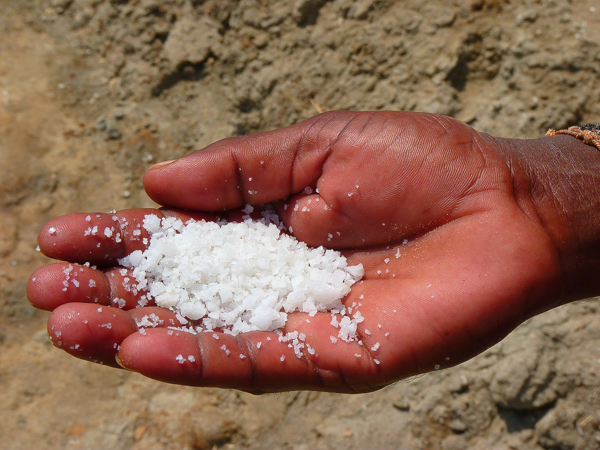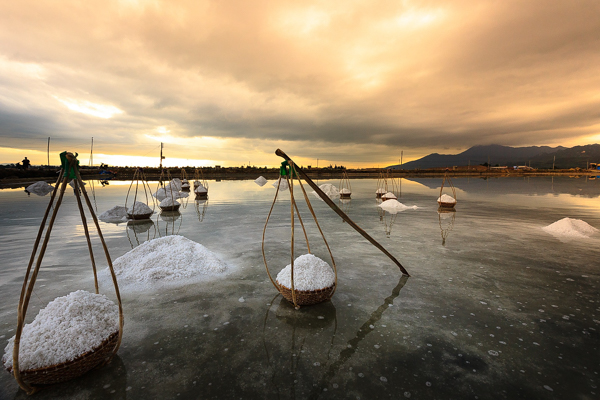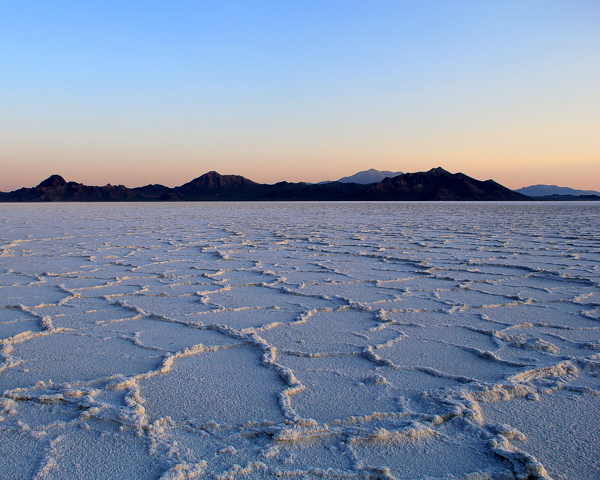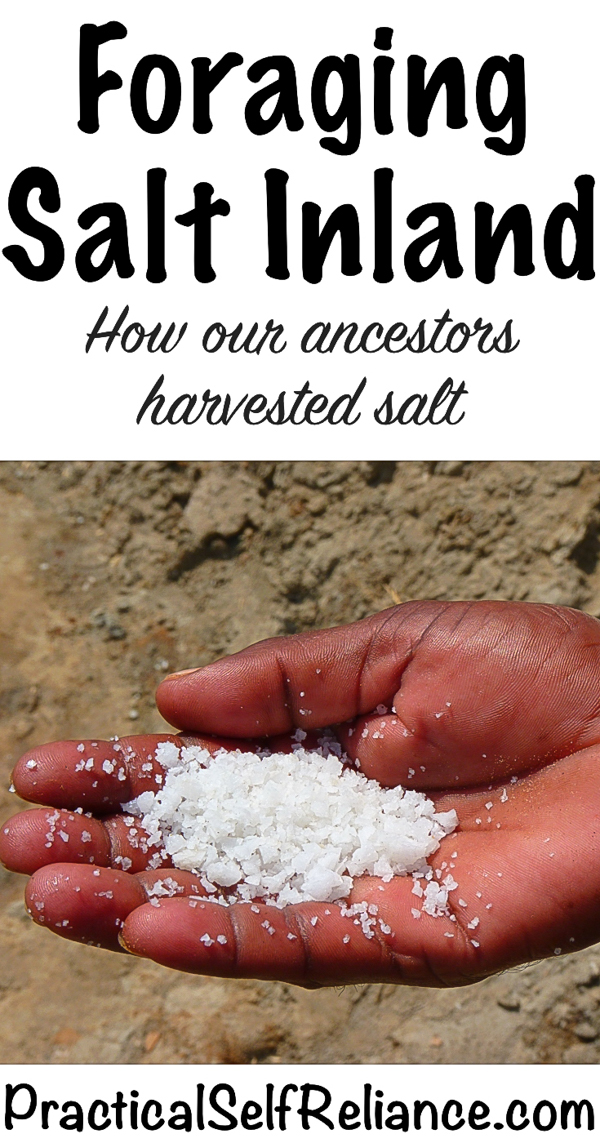Affiliate disclosure: This post may contain affiliate links. Please see our Privacy Policy.
I found myself wondering, how did our ancestors in landlocked regions find salt? I know. The weird things I wonder about…
It’s easy enough to harvest sea salt from the ocean, but what if you’re settled a thousand miles from the ocean?
I’ve heard explanations that even ancient peoples relied on trade, but I can’t imagine they would have relied exclusively on trade for such a vital resource.

I just can’t believe it. You’re going to settle 1,500 miles from the coast. Literally months of walking, and assume that someone’s going to want what you have bad enough to bring you salt along a trade route.
Maybe. But perhaps that’s why I’m not a pioneer. I’d need to know where to find it inland before I’d venture inland.
Salt is essential for human survival, down to basic cellular functions. It’s also required for many different preservation techniques, especially those that preserve meat without refrigeration. Beyond basic survival, salt is also one of the basic human flavors that we can taste, and it goes a long way to making food not only palatable but pleasurable.
I’m not the only one who’s wondered, and it turns out researchers pieced together 6 different ways native Americans gathered salt.
Harvesting Sea Salt
Extracting salt from seawater is by far the easiest method, but it obviously only works near the sea.
There’s a surprising amount of harvestable salt in seawater, and a single gallon contains just over 1/4 pound of sea salt. It can be extracted by boiling away the water, or by placing it in shallow trays exposed to the sun and allowing the water to evaporate.
In some areas with rocky beaches and shallow tide pools, large salt crystals can be collected daily toward the end of low tide just before the water comes back in, no boiling required.

Extracting Salt from Sand
Sandy inland soils can contain salt deposits, and local tribes would be well aware of prime sources near their homeland. Sand was placed in a basket with very small holes at the bottom and water washed through it. The water was then boiled down like seawater, resulting in salt extracted from deposits inland. Here’s a description of the process from a first-hand account:
“The salt is made along by a river, which, when the water goes down, leaves it upon the sand. As they cannot gather the salt without a large mixture of sand, it is thrown together into certain baskets they have for the purpose, made large at the mouth and small at the bottom. These are set in the air on a ridge-pole; and water being thrown on, vessels are placed under them wherein it may fall; then, being strained and placed on the fire, it is boiled away, leaving salt at the bottom.” (Source)
Harvesting Rock Salt
Those that lived near a rock salt source could travel every year to actually mine out their salt with hand tools. There are many such deposits up and down the east coast, many of which are underground and are not accessible directly. Instead, they feed brine springs where native Americans would travel to gather salt.
Harvesting Salt from Brine Springs & Salt Lakes
Brine springs are by far the most common documented source of salt for native peoples. Salt boiling pots are found in archeological records from tribes throughout the United States. Oral histories tell stories of families continuing this tradition even today.
Every year the family or settler group travels to a salt spring to collect the nearby salt, taking turns tending fires to heat stones that are then placed into clay pots to boil water. Eventually, the salt is scraped from the insides of these pots and stored for a year’s supply. In more modern times, metal pots are used directly over the fire, but the concept is the same.

Salt in Animal Blood
Since many plants contain salts in low concentration, you’d either need to burn a lot of them or eat a lot of them to get enough salt to survive. Herbivores, such as deer, browse the forest and actively seek out salt-rich plants and mineral salt deposits to lick.
That salt accumulates in their tissues and is present in their blood. While there’s not a particularly good way to extract salt from animal blood, consuming it regularly will supply enough salt to keep you healthy in the absence of other sources.
Far from the ocean, animal and plant salt sources tend to be low in iodine, which is one reason commercially made salt is supplemented with iodine. Soils vary in iodine content, and mountainous soils tend to be especially deficient. In those areas, a salt spring or rock salt source is the most reliable for maintaining good health in the absence of commercial salt.
Extracting Salt from Plant Ashes
Explorers also recorded native Americans burning the leaves and roots of certain plants to extract their salts. Very little has been documented about which plants these may have been.
Survivalists today know that boiling hickory roots will result in a black tar-like substance that is full of edible salts. Likewise, wild carrot and parsnip are good boiled salt sources.
Coltsfoot, a common weed, can be burned for salt. The leaves are first dried, and then tightly rolled. They’re lit at one end and slowly burned over a container that catches the ash.
Once the plant matter has burned away, you’re left with the mineral salts accumulated by the plant. Though it takes a significant amount of plant matter to make even a small amount of salt, coltsfoot is a particularly aggressive weed, growing in even the most abused soils, especially in urban or suburban areas and along roadsides.
This method I’m particularly intrigued by. This summer I hope to gather some coltsfoot to burn for salt. It should be easy enough, it grows just about everywhere.
Final Thoughts on Salt for Preservation
In the course of writing this, I learned that using salt to preserve the meat from large animal harvests is a European practice. “The Indians of Eastern North America apparently used salt as a condiment. There is no evidence for salt ever having been used historically for preserving meat or fish, as drying game over a low fire was the standard Southeastern method of preservation.”
I assumed that salt was essential for preserving meat without refrigeration, but the practice of salt-based charcuterie is a regional specialty.
Nonetheless, salt is still tasty and living in a landlocked state, I’m excited to begin looking for our own salt springs and local sources.





I used our crockpot to reduce water from the Florida Gulf coast this year. Worked really welI: I got a heaping handful of salt from a gallon of seawater.
Are you able to elaborate on method of deriving salt from wild parsnip please? And to be clear, we are talking about the weed that has a flat round flower and the sap of which causes burns to the skin? (Also called hogweed.). Thanks for all the information you share, I am learning so much!
Giant Hogweed—Heracleum mantegassianum and Wild Parsnip-Pastinaca sativa are two different plants. There are also several other look a likes so it is important to know your plant identification. The wild parsnips are boiled to extract the salt.
Celery also has a lot of sodium, no?
It has about 88 milligrams per cup which is on the higher side for a vegetable.
I’m wondering if you were able to process the coltsfoot? If so, did it work? How did you do it? Thanks!
When you say process it, do you mean making the salt with it? If so there is a section in the blog post under the heading “Making Coltsfoot Salt” which describes both the process of making the salt and also the outcome.
Thank you! I’ll go back.to take another look.
You’re very welcome.
Thank you for this post. Since I often suffer with headaches, I’ve also wondered about the effect of lack of minerals.
You’re very welcome. We’re so glad you enjoyed the post.
You are not the only one thinking these thoughts lol. I find myself also thinking freely like this when I should really be working. It was one of the first things I was thinking about when first learning about prepping. We are in Ontario Canada, and not many salt mines where we are, generally only in Western Ontario. This was very informative and it looks like for now my option is plant material.
Keep up the great articles and information. Much appreciated!
You’re very welcome. So glad you enjoyed the post.
I am very grateful to you for this post. I too often wondered about salt, for people living in the mountains. Thank you
You’re very welcome. So glad you enjoyed the post.
THANKS !’
You’re welcome.
Question: Regarding Chenopodium used as a salt source. Can you give me other references or citations confirming your statement?
I first met the Negrito moutain people of the P.I. in 1966 as a Navy SERE – POW Inst. – at the USN JEST school , NAS Cubi Pt. GREAT experience ! Later in 1975- 78 I was assigned to JEST Inst duty. My Native Amer. wife , son and I LOVED that duty.! Everyday was a total learning experience- as I squeezed day pf learning, sharing with our local Troopers. A couple had been Scouts in WW-II. I took pictures, write pages, learning ( someday it all may be a book, ha) I Ret in 1982 and have return several times . I will be #80 next yr and I will return – Now with 50 + yrs experience n survival from the Arctic – to the Amazon . I HAVE ALWAYS SEARCHED FOR THE ANSWER AS TO WHERE TO GATHER MY SALT NEEDS. ! our Negrito people used the blood from the animals. One selected burning the green bamboo and pour water through the ashes (???).
Next trip, 2022, I sure will continue to reaeCh and test with my village friends ( I will also try and test in the Amazon with friends. ) ” Mtn Mel in W. Colo. tipi camp.
This is incredible. Thanks so much for sharing. So glad you enjoyed the post.
The east coast natives used to bur chenopodium to retrieve the salt from it. Initially, before the advent of corn, it was a grain crop (similar to quinoa). When the first Europeans arrived, it was still raised in some places they visited for grain, and the leaves and stems were burned, the ashes used to salt food for seasoning. Colloquially, it is known by such names as “goosefoot”, and as far as I know it grows wild practically nationwide. It seems to have a particular affinity for drawing salts from the ground as it grows.
Anyone know of any rock salt or salt brine seeps near Northampton, MA? It’s too far inland to to coastal sea salt. Looking to mine some so I’m not 100% reliant on plant ash extraction which is slow. Not enough sand around here to be a useful source of salt.
I am in the north west corner of the high desert plains, South central oregon. Are there salt plants that are indigenous to here.
I’m not familiar with the plants in that area, but maybe another reader is and can comment with some ideas for you.
I read in some book on Native Americans in the upper Missouri river basin using the dried and burned to ashes cob of the corn ear for a condiment. Apparently is is salt rich, as well.
Wow! This is an incredible resource. As a fellow Vermonter, I often wondered this same thing – I can’t believe how much more I know now!! I’m looking forward to trying out coltsfoot as a salt source this summer as well. I just saw my first coltsfoot bloom yesterday! Very exciting. Cheers!
Hey Kate, I just saw our first coltsfoot blooms this morning. Soon! It was interesting that every map I could find about salines and harvesting salt had to do with either the south around Louisiana or right in the middle of the country around Ohio. I really wish I could find maps (or local knowledge) of salines in Vermont, then I’d go out and give it a try.
I live near Salisbury beach which is salt water, I’ve gathered seaweed for my garden and believe me even though I washed it several times it’s salt content was still high. I’ve already prepped alot of salt but not by this method. Can you send me the exact way to accomplish getting salt from the water? Thanks,,Lisa
You put the salt water in a pan and boil it. The water evaporates as it boils. Let it boil until there is no more liquid in the pan, leaving just a layer of white salt at the bottom of the pan. Scrape this layer into a pile or container of your choice.
Thank you so much for writing this! I was very curious about this topic and reading this article served me well!
Awesome. I’m so glad you liked it!